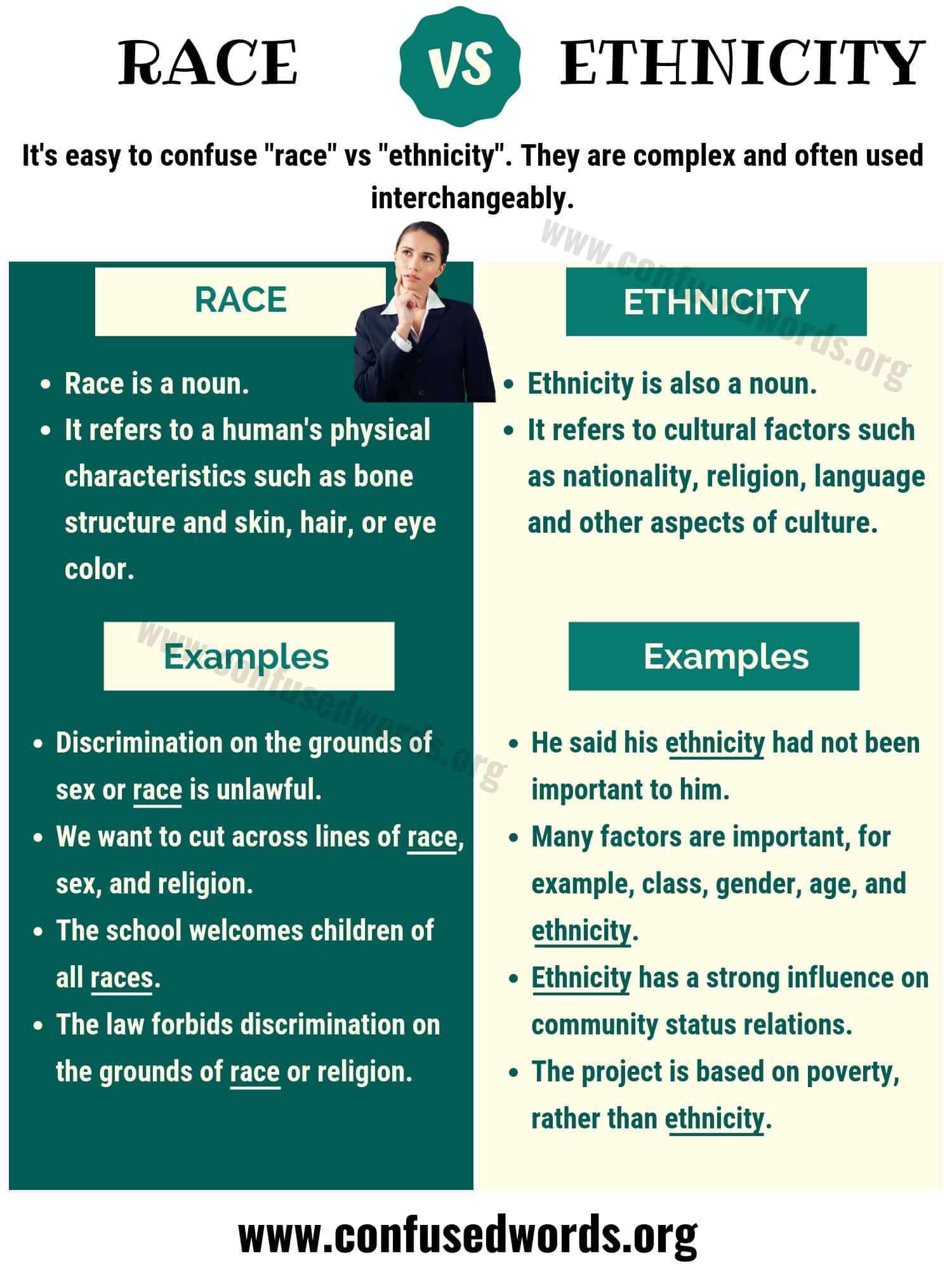Understanding What Is The Difference Between Race And Ethnicity: A Comprehensive Guide
What is the difference between race and ethnicity? It’s a question that often arises in discussions about identity, culture, and society. While these terms are sometimes used interchangeably, they represent distinct concepts that shape how individuals and communities perceive themselves and others. Race typically refers to physical characteristics such as skin color, facial features, and hair texture, which have historically been used to categorize people into groups. Ethnicity, on the other hand, is tied to cultural factors like language, traditions, and shared ancestry. Understanding these nuances is crucial for fostering mutual respect and dismantling stereotypes in an increasingly globalized world.
Why does this distinction matter? The answer lies in how race and ethnicity influence social dynamics, policies, and personal experiences. For example, race has often been a basis for discrimination and systemic inequality, while ethnicity plays a significant role in cultural pride and heritage. Both concepts intersect with other aspects of identity, such as nationality and religion, creating a complex web of human diversity. By unpacking these differences, we can better appreciate the richness of human experience and work toward a more inclusive society.
This article will explore what is the difference between race and ethnicity in depth, examining their historical roots, societal implications, and the ways they shape individual lives. Through a mix of definitions, examples, and expert insights, we aim to provide a clear and engaging guide that answers common questions and sheds light on this important topic. Whether you’re a student, educator, or simply curious, this exploration will equip you with the knowledge to navigate conversations about identity with confidence.
Read also:Kirk Herbstreit Son A Comprehensive Look At His Life And Legacy
Table of Contents
- What Are the Core Differences Between Race and Ethnicity?
- How Have Historical Events Shaped Our Understanding of Race and Ethnicity?
- What Role Do Cultural Factors Play in Defining Ethnicity?
- How Does Race Influence Social Structures?
- How Do Individuals Navigate Identity and Self-Perception?
- What Is the Role of Intersectionality in Understanding Identity?
- What Are the Most Common Misconceptions About Race and Ethnicity?
- Where Are We Headed in the Future of Identity Discussions?
What Are the Core Differences Between Race and Ethnicity?
To fully grasp what is the difference between race and ethnicity, it’s essential to delve into their definitions and characteristics. Race is primarily a social construct based on physical traits, such as skin color, hair type, and facial features. These traits have historically been used to categorize people into groups, often with significant social and political implications. For instance, racial categories have been used to justify discrimination, segregation, and even colonization. However, it’s important to note that race is not a scientifically valid concept; genetic research has shown that there is more variation within so-called racial groups than between them.
Ethnicity, by contrast, is rooted in cultural identity. It encompasses shared traditions, languages, religions, and histories that bind a group together. Unlike race, which is often externally imposed, ethnicity is something individuals may choose to embrace or reject. For example, someone of Mexican descent living in the United States might identify as ethnically Mexican, celebrating traditions like Día de los Muertos, while also identifying as racially white or mestizo. This flexibility highlights the fluid nature of ethnicity compared to the more rigid categorizations often associated with race.
Understanding these distinctions can help clarify why the two terms are not interchangeable. While race is tied to physical appearance and often carries societal baggage, ethnicity is about cultural belonging and personal connection. Both, however, intersect in complex ways, influencing how individuals experience the world. For instance, a person might face racial discrimination while simultaneously feeling a deep sense of pride in their ethnic heritage. Recognizing these nuances is the first step toward fostering a more inclusive and empathetic society.
How Have Historical Events Shaped Our Understanding of Race and Ethnicity?
The concepts of race and ethnicity have evolved significantly over time, shaped by historical events, colonialism, and scientific advancements. In the 18th and 19th centuries, race was often used to justify social hierarchies and exploitation. For example, European colonial powers employed racial classifications to assert their dominance over colonized peoples, reinforcing stereotypes that persist to this day. Similarly, the transatlantic slave trade relied heavily on racial categorizations to dehumanize African populations and justify their enslavement.
How Did Colonialism Impact Ethnic Identities?
Colonialism not only reinforced racial divisions but also disrupted ethnic identities. Indigenous cultures were often suppressed or erased as colonizers imposed their languages, religions, and customs. In many cases, ethnic groups were forced to assimilate, leading to a loss of cultural heritage. For instance, Native American tribes in the United States were subjected to policies aimed at eradicating their languages and traditions, creating lasting scars on their communities.
What Role Did Science Play in Shaping Race?
Scientific racism, a now-discredited field, sought to provide biological justifications for racial hierarchies. This pseudoscience claimed that certain races were inherently superior or inferior, perpetuating harmful stereotypes. Although modern genetics has debunked these ideas, the legacy of scientific racism continues to influence societal attitudes. Understanding this history is crucial for dismantling the biases that persist today.
Read also:Mastering The Spotify Web Player Your Ultimate Guide To Streaming Music Online
What Role Do Cultural Factors Play in Defining Ethnicity?
Ethnicity is deeply intertwined with cultural factors such as language, religion, and traditions. These elements serve as markers of identity, helping individuals connect with their heritage and community. For example, language is often a key component of ethnic identity, with many people taking pride in speaking their ancestral tongue. Similarly, religious practices can reinforce a sense of belonging, as seen in the way holidays like Diwali or Ramadan bring communities together.
Why Is Language Important to Ethnic Identity?
Language is more than just a means of communication; it’s a vessel for cultural knowledge and values. When a language is lost, so too is a piece of cultural heritage. Efforts to preserve endangered languages, such as Hawaiian or Welsh, highlight the importance of language in maintaining ethnic identity. By learning and teaching these languages, communities can reclaim their cultural narratives and resist assimilation.
How Does Race Influence Social Structures?
Race has long been a determinant of social and economic opportunities, influencing everything from education to employment. In many societies, racial minorities face systemic barriers that limit their access to resources and privileges. For example, redlining in the United States denied Black families the opportunity to purchase homes in certain neighborhoods, perpetuating cycles of poverty and inequality. These structural inequities underscore the need for policies that address racial disparities.
What Are the Implications of Racial Stereotypes?
Racial stereotypes are pervasive and damaging, shaping how individuals are perceived and treated. These stereotypes can lead to discrimination in hiring, law enforcement, and healthcare, among other areas. Challenging these biases requires a collective effort to educate and raise awareness, ensuring that people are judged by their actions rather than their appearance.
How Do Individuals Navigate Identity and Self-Perception?
For many people, identity is a complex interplay of race, ethnicity, and personal experiences. Some individuals may feel a strong connection to their racial identity, while others prioritize their ethnic heritage. This self-perception is shaped by factors such as family upbringing, community influences, and societal expectations. Understanding how individuals navigate these layers of identity can foster greater empathy and respect.
What Is the Role of Intersectionality in Understanding Identity?
Intersectionality highlights how race and ethnicity intersect with other aspects of identity, such as gender, class, and sexuality. This framework reveals the unique challenges faced by individuals who belong to multiple marginalized groups. For example, a Black woman may experience discrimination differently than a Black man or a white woman, underscoring the importance of considering multiple dimensions of identity.
What Are the Most Common Misconceptions About Race and Ethnicity?
One common misconception is that race and ethnicity are fixed and unchanging. In reality, both are fluid and can evolve over time. Another misconception is that these categories are universally understood, when in fact their meanings vary across cultures and contexts. Dispelling these myths is essential for promoting accurate and respectful discussions.
Where Are We Headed in the Future of Identity Discussions?
As society becomes increasingly diverse, conversations about race and ethnicity will continue to evolve. Advances in technology, such as DNA testing, are reshaping how people understand their ancestry and identity. At the same time, movements for racial and ethnic justice are challenging outdated norms and advocating for greater inclusivity. By embracing these changes, we can build a future that celebrates human diversity in all its forms.
Frequently Asked Questions
What Is the Difference Between Race and Ethnicity?
Race refers to physical characteristics like skin color, while ethnicity is tied to cultural factors such as language and traditions. Both influence identity but in different ways.
Can Someone Belong to Multiple Races or Ethnicities?
Yes, many individuals identify as multiracial or multiethnic, reflecting the complexity of human identity.
Why Is It Important to Understand These Differences?
Understanding race and ethnicity fosters empathy, dismantles stereotypes, and promotes inclusivity in diverse societies.
For further reading, explore this resource on anthropology and identity.
Is Michael J. Fox Dead? The Truth Behind The Rumors
Bruce Robert Hough: The Visionary Leader Transforming Industries
Who Is Shamari Fears Devoe? A Deep Dive Into The Rising Star's Journey

Difference Between Race And Ethnicity NBKomputer

Race vs ethnicity what is the difference between them? Live Science